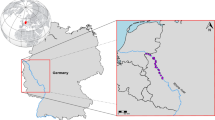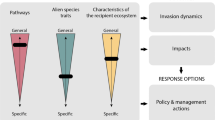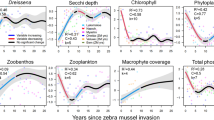Abstract
Insight from theory has shown the usefulness of considering time lags in both plant and animal invasions, but this topic has yet to be fully explored with real examples. Here we define and investigate several types of lags using Red Sea fish invasions of the Mediterranean as a case study. By exploring both conceptual and analytical aspects of time lags, we suggest that this concept can be applied to both the ecology and management of invasions. Through the review of available literature and by compiling a comprehensive geo-referenced database, we show that our understanding of the temporal nature of invasion can be confounded by our varying capability to perceive it. This deep, sometimes inextricable, connection between the temporal nature of a process and its observation represents a critical issue for our understanding of the Lessepsian phenomenon, and is a challenge for invasion biology more generally. While our case study is associated with a very specific date in which the Suez Canal opened, our framework is expected to broaden the notion of time lags in bioinvasions research.






Similar content being viewed by others
References
Aagaard K, Lockwood J (2014) Exotic birds show lags in population growth. Divers Distrib 20:547–554
Akyol O, Ünal V, Ceyhan T, Bilecenoglu M (2005) First confirmed record of the silverside blaasop, Lagocephalus sceleratus (Gmelin, 1789), in the Mediterranean Sea. J Fish Biol 66:1183–1186
Azzurro E, Soto S, Garofalo G, Maynou F (2012) Fistularia commersonii in the Mediterranean Sea: invasion history and distribution modeling based on presence-only records. Biol Invasions 15:977–990
Azzurro E, Soto S, Bariche M, Fanelli E, Maynou F (2013) Exotic fish species in the Mediterranean Sea: analysis of occurrence records. Rapp Comm Int Mer Médit 40:598
Azzurro E, Tuset VM, Lombarte A, Maynou F, Simberloff D, Rodríguez-Pérez A, Solé RV (2014) External morphology explains the success of biological invasions. Ecol Lett 17:1455–1463
Azzurro E, Goren M, Diamant A, Galil B, Bernardi G (2015) Establishing the identity and assessing the dynamics of invasion in the Mediterranean Sea by the dusky sweeper, Pempheris rhomboidea Kossmann & Räuber, 1877 (Pempheridae, Perciformes). Biol Invasions 17:815–826
Barbour AB, Allen MS, Frazer TK, Sherman KD (2011) Evaluating the potential efficacy of invasive lionfish (Pterois volitans) removals. PLoS ONE 6(5):e19666
Bariche M, Kazanjian G, Azzurro E (2013) A lag of 25 years: evidence from an old capture of Fistularia commersonii Rüppell, 1838 from Lebanon (Mediterranean Sea). J Appl Ichthyol 3:535–536
Bellard C, Genovesi P, Jeschke JM (2016) Global patterns in threats to vertebrates by biological invasions. Proc R Soc B 283:20152454. doi:10.1098/rspb.2015.2454
Belmaker J, Brokovich E, China V, Golani D, Kiflawi M (2009) Estimating the rate of biological introductions. Ecology 90:1134–1141
Belmaker J, Brokovich E, China V, Golani D, Kiflawi M (2010) Introduction rates of Lessepsian fishes in the Mediterranean. In: Golani D, Applebaum-Golani B (eds) Fish invasions of the Mediterranean Sea, change and renewal. Pensoft, Sofia, pp 35–56
Ben Rais Lasram F, Guilhaumon F, Mouillot D (2010) Global warming and exotic fishes in the Mediterranean Sea: introduction dynamic, range expansion and spatial congruence with endemic species. In: Golani D, Applebaum-Golani B (eds) Fish invasions of the Mediterranean Sea, change and renewal. Pensoft, Sofia, pp 35–56
Ben-Souissi J, Rifi M, Ghanem R, Ghozzi L, Boughedir W, Azzurro E (2014) Lagocephalus sceleratus (Gmelin, 1789) expands through the African coasts towards the Western Mediterranean Sea: a call for awareness. Manag Biol Invasions 5:357–362
Ben-Tuvia A (1978) Immigration of fishes through the Suez Canal. Fishery Bull 76:249–255
Bernardi G, Azzurro E, Golani D, Miller M (2016) Genomic signatures of rapid adaptive evolution in the bluespotted cornetfish, a Mediterranean Lessepsian invader. Mol Ecol. doi:10.1111/mec.13682
Bilecenoglu M (2010) Alien marine fishes of Turkey-an updated review. In: Golani D, Applebaum-Golani B (eds) Fish invasions of the Mediterranean Sea, change and renewal. Pensoft, Sofia, pp 189–217
Bilecenoglu M, Russell BC (2008) Record of Nemipterus randalli Russell, 1986 (Nemipteridae) from Iskenderun Bay, Turkey. Cybium 32:279–280
Blackburn TM, Pisek P, Bacher S, Bacher S, Carlton JT, Duncan RP, Jarosik V, Wilson JRU, Richardson D (2011) A proposed unified framework for biological invasions. Trends Ecol Evol 26:333–339
Costello CJ, Solow AR (2003) On the pattern of discovery of introduced species. Proc Natl Acad Sci 100:3321–3323
Crooks JA (2005) Lag times and exotic species: the ecology and management of biological invasions in slow-motion. Ecoscience 12:316–329
Crooks JA (2011) Lag times. In: Simberloff D, Rejmánek M (eds) Encyclopedia of Biological invasions. University of California Press, Oakland, pp 404–410
Daehler CC (2009) Short lag times for invasive tropical plants: evidence from experimental plantings in Hawai’i. PLoS ONE 4(2):e4462
Essl F, Dullinger S, Rabitsch W, Hulme PE, Hülber K et al (2011) Socioeconomic legacy yields an invasion debt. Proc Natl Acad Sci 108:203–207
Fricke R, Golani D, Appelbaum-Golani B (2012) First record of the Indian Ocean anchovy Stolephorus insularis Hardenberg, 1933 (Clupeiformes: Engraulidae) in the Mediterranean. BioInvasions Rec 1(4):303–306
Galil BS (2006) The marine caravan – the Suez Canal and Erythrean invasion. In: Gollasch S, Galil BS, Cohen AN (eds) Bridging divides. Maritime canals as invasion corridors. Springer, Dordrecht, pp 207–300
Galil B (2009) Taking stock: inventory of alien species in the Mediterranean sea. Biol Invasions 11:359–372
Galil BS, Boero F, Campbell ML, Carlton JT, Cook E, Fraschetti S et al (2015) ‘Double trouble’: the expansion of the Suez Canal and marine bioinvasions in the Mediterranean Sea. Biol Invasions 17:973–976
Genovesi P, Scalera R, Brunel S, Roy D, Solarz W (2010) Towards an early warning and information system for invasive alien species (IAS) threatening biodiversity in Europe. EEA, Technical Report 5:1–49
Golani D (2000) The Lessepsian migrant, the Red-eye Round Herring, Etremeus teres (DeKay, 1842), a new record from Cyprus. Zool Middle East 20:61–64
Golani D (2010) Colonization of the Mediterranean by Red Sea fishes via the Suez Canal—Lessepsian migration. In: Golani D, Appelbaum-Golani B (eds) Fish invasions of the mediterranean sea: Change and reneval. Pensoft Publishers, Sofia, pp 145–188
Golani D, Ben-Tuvia A (1985) The biology of the Indo-Pacific squirrelfish, Sargocentron rubrum (Forsskål), a Suez Canal migrant to the eastern Mediterranean. J Fish Biol 27:249–258
Golani D, Massutí E, Orsi-Relini L, Quignard JP, Dulčić J, Azzurro E. (2013) CIESM atlas of exotic fish species. http://www.ciesm.org/atlas/appendix1.html Accessed 28 June 2015
Golani D, Askarov G, Dashevsky Y (2015) First record of the Red Sea spotted grouper, Epinephelus geoffroyi (Klunzinger, 1870) (Serranidae) in the Mediterranean. BioInvasion Records 2:143–145
Jørgensen C, Myron E, Peck A, Antognarelli F, Azzurro E et al. (2012) Conservation physiology of marine fishes: advancing the predictive capacity of models. Biol Lett. 8: 900–903. rsbl20120609
Larkin DJ (2012) Lengths and correlates of lag phases in upper-Midwest plant invasions. Biol Invasions 14:827–838
Le Maitre DC, Richardson DM, Chapman RA (2004) Conservation Physiology of Marine Fishes: advancing the predictive capacity: working for water. S Afr J Sci 100:103–112
Lelli S, Colloca F, Carpentieri P, Russell BC (2008) The threadfin bream Nemipterus randalli Russell, 1986 (Perciformes; Nemipteridae) in the eastern Mediterranean Sea. J Fish Biol 60:1326–1330
Macias D, Garcia-Gorriz E, Stips A (2013) Understanding the causes of recent warming of Mediterranean waters. How much could be attributed to climate change? PLoS ONE 8(11):e81591
Mack RN, Simberloff D, Lonsdale WM, Evans H, Clout M, Bazzaz FA (2000) Biotic invasions: causes, epidemiology, global consequences, and control. Ecol Appl 10:689–710
Marras S, Cucco A, Antognarelli F, Azzurro E, Milazzo M, Bariche M, Butenschön M, Kay S, Di Bitetto M, Quattrocchi G, Sinerchia M, Domenici P (2015) Predicting future thermal habitat suitability of competing native and invasive fish species: from metabolic scope to oceanographic modelling. Cons Physiol 3.1:cou059. doi:10.1093/conphys/cou059
McNeely JA (ed) (2001) The great reshuffling: human dimensions of invasive alien species. Gland, Switz./Cambridge, UK: IUCN
Parravicini V, Azzurro E, Kulbicki M, Belmaker J (2015) Niche shift can impair the ability to predict invasion risk in the marine realm: an illustration using Mediterranean fish invaders. Ecol Lett 18:246–253
Por FD (1971) One hundred years of Suez Canal: a century of Lessepsian migration. Syst Zool 20:138–159
Raitsos DE, Beaugrand G, Georgopoulos D, Zenetos A, Pancucci-Papadopoulou AM, Theocharis A, Papathanassiou E (2010) Global climate change amplifies the entry of tropical species into the Eastern Mediterranean Sea. Limn Ocean 55:1478–1484
Ricciardi A (2013) Invasive species. In: Leemans R (ed) Ecological systems. Springer, New York, pp 161–178
Rilov G, Benayahu Y, Gasith A (2004) Prolonged lag in population outbreak of an invasive mussel: a shifting-habitat model. Biol Invasions 6:347–364
Russell BC, Golani D, Tikochinski Y (2015) Saurida lessepsianus a new species of lizardfish (Pisces: Synodontidae) from the Red Sea and Mediterranean Sea, with a key to Saurida species in the Red Sea. Zootaxa 3956:559–568
Simberloff D, Rejmánek M (eds) (2010) Encyclopedia of biological invasions, vol 3. University of California Press, Oakland
Solow AR, Costello CJ (2004) Estimating the rate of species introductions from the discovery record. Ecology 85:1822–1825
Spanier E (2000) Changes in the ichthyofauna of an artificial reef in the southeastern Mediterranean in one decade. Sci Mar 64:279–284
Steinitz W (1927) Beitrage zur Kenntnis der Küstenfauna Palästinas. Pubblicazioni della Stazione Zoologica di Napoli 8:311–353
Tillier JE (1902) Le Canal de Suez et sa faune ichthylogique. Mémoires de la Société zoologique de France 15:279–318
Whitney KD, Gabler CA (2008) Rapid evolution in introduced species, ‘invasive traits’ and recipient communities: challenges for predicting invasive potential. Divers Distrib 14:569–580
Witte S, Buschbaum C, Van Beusekom JE, Reise K (2010) Does climatic warming explain why an introduced barnacle finally takes over after a lag of more than 50 years? Biol Invasions 12:3579–3589
Zalasiewic J, Williams M, Steffen W, Crutzen P (2010) The new world of the Anthropocene. Environ Sci Technol 44:2228–2231
Author information
Authors and Affiliations
Corresponding author
Electronic supplementary material
Below is the link to the electronic supplementary material.
Rights and permissions
About this article
Cite this article
Azzurro, E., Maynou, F., Belmaker, J. et al. Lag times in Lessepsian fish invasion. Biol Invasions 18, 2761–2772 (2016). https://doi.org/10.1007/s10530-016-1184-4
Received:
Accepted:
Published:
Issue Date:
DOI: https://doi.org/10.1007/s10530-016-1184-4




